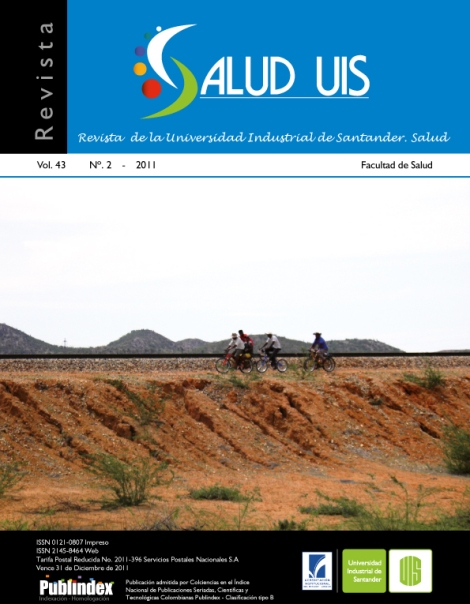Resumo
Introducción: Las infecciones intrahospitalarias constituyen un problema de salud pública mundial, la diseminación de bacterias patógenas a partir del personal de salud, ha sido el enfoque de numerosas investigaciones que buscan mejorar la calidad de vida de los pacientes.
Objetivo: Determinar la frecuencia de portadores de Staphylococcus aureus en fosas nasales del personal que labora en las unidades de cuidados intensivos, infectología pediátrica y lactario en un Hospital en Santander.
Metodología: Se estudiaron muestras provenientes de fosas nasales de 87 trabajadores del Hospital. Las cepas aisladas se identificaron mediante las pruebas bioquímicas y posteriormente, se determinó el perfil de susceptibilidad ante diferentes antibióticos, se realizó test D a las cepas de S. aureus.
Resultados: La frecuencia deportadores de bacterias patógenas fue 41,4%; el patógeno aislado con mayor frecuencia fue S. aureus(72%), donde el porcentaje de S. aureus meticilino-resistentes (SARM) fue de 11,6%, Enterobacteraerogenes (6%), Proteus mirabilis (2,3%), Haemophylus influenzae (1,1%), Citrobacter koseri (1,1%)y Providencia rettgeri (1,1%).
Conclusiones: S. aureus es el agente aislado con mayor frecuencia de las fosas nasales del personal de salud y la presencia de SARM es preocupante por su resistencia a los antibióticos, lo que dificulta su tratamiento. Este hecho evidencia la necesidad de actuar con un carácter preventivo, en el cual el control de portadores es crítico y debe asociarse con medidas de bioseguridad que establezcan barreras más eficientes, para reducir la diseminación del microorganismo y la ocurrenciade infecciones intrahospitalarias.
Salud UIS 2011; 43 (2): 111-117
Palabras clave: Portador nasal, infecciones intrahospitalarias, bacterias patógenas, Staphylococcusaureus
ABSTRACT
Introduction: Nosocomial infections are a public health problem worldwide, its spread start from health personnelcarrier of pathogenic bacteria, it has been the focus of a large number of research to improve the quality of life ofthe patients.
Objective: To determine the frequency of nasal carriers of Staphylococcus aureus in the personnelthat works in intensive care units (adults ICU and pediatric ICU), pediatric infectology and lactary in a Hospitalin Santander.
Methodology: Nasal samples from 87 workers from of the Hospital were studied. Isolated strainswere identified by the corresponding biochemical tests and subsequently determined their susceptibility profiles todifferent antibiotics and test D for S. aureus. Results: The frequency of nasal carriers of pathogenic bacteria was41.4%; it was found that S. aureus was the most isolated pathogenic microorganism, with a frequency of (72%). Thepercentage of meticilin resistant S. aureus (MRSA) was 11.6% , Enterobacter aerogenes (6%), Proteus mirabilis(2.3%); Haemophylus influenzae (1.1%); Citrobacter koseri (1.1%) and Providencia rettgeri (1.1%).
Conclusion:S. aureus is the most frequently isolated agent in health personnel’s nasal nostrils and the presence of MRSA isworrying, additionally, it presents characteristic of resistance to antibiotics, making harder its treatment. This factevidences the necessity to act with a preventive character, in which the control of carriers is critical and it should beassociated with biosecurity measures to establish effective barriers to reduce the dissemination of the microorganismand occurrence of nosocomial infections. Salud UIS 2011; 43 (2): 111-117
Keywords: Nasal carrier, nosocomial infections, pathogenic bacteria, Staphylococcus aureus
Se autoriza la reproducción total o parcial de la obra para fines educativos, siempre y cuando se cite la fuente.
Esta obra está bajo una Licencia Creative Commons Atribución 4.0 Pública Internacional.
